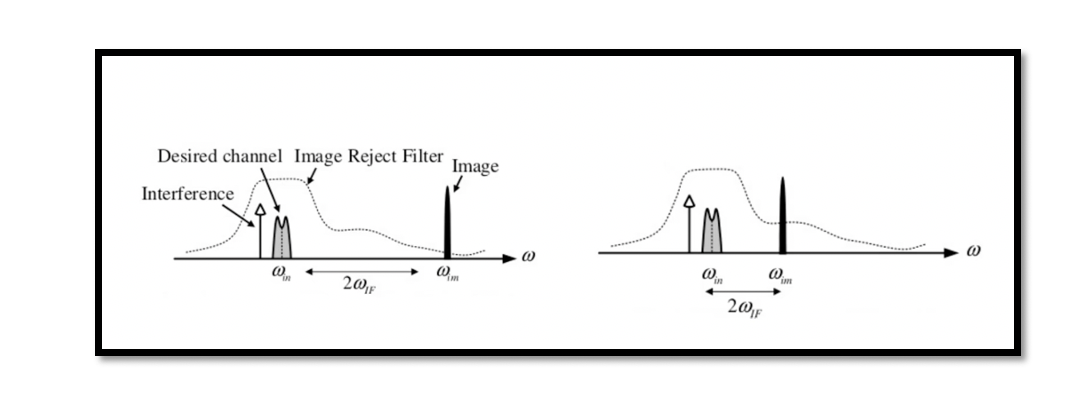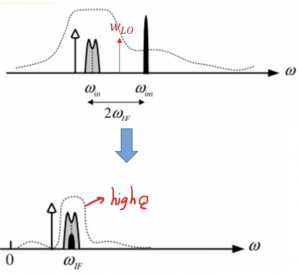
Trade-off between Image Rejection and Channel Selection
Understanding the trade-off in choice of IF
There is a trade-off between image rejection and channel selection receiver. So there are two options in selecting the frequency of the local oscillator, or carrier says we have two options in choosing the frequency of local Slater carrier. So we will have two options in selecting the intermediate frequency (IF).
Case 1: When wLO is far from the channel or high wIF.
The local oscillator frequency is selected in such a way that it is far away from our desired channel win. The figure below shows that win is a bit far away from wLO, and it is high-side injection WIF = WLO – Win. The intermediate frequency will be high as the difference here is huge.

The advantage of this approach is when win is selected far from wLO, maximizing image rejection happens, and a high Q filter is not required. The image signal will appear in a frequency far from wLO as the difference between wLO and image is the same as wIF. So the main advantage of this approach is image rejection. The filter can be designed that doesn’t need to be high Q because now the image is far from winning. The difference between channel frequency win and image signal wim is a very large value equal to 2wIF, which gives a space to design and place a filter there, rejecting the image signal completely. Firstly, it is far from the channel. Secondly, this bandpass filter designed will have high attenuation at this point. However, we do have disadvantages to this approach.
The disadvantage of this approach is that wIF is high, making it difficult to select the desired channel. In a band, the channels are quite too close to each other, so in order to select our desired channel within a band, a high Q filter will be required, and as we are operating in high wIF, we won’t be able to design it, we are operating in high frequency. Therefore, we can attenuate the image but selecting a channel would be difficult.
Case 2: When wLO is close to channel or low wIF
The local oscillator frequency is selected in such a way that it is close to our desired channel win.

The advantage of this approach is that now because the wLO is close to win, we will have low wIF, so now, when you go to an intermediate frequency high Q filter, we can be designed as we are operating in lower frequency. As shown in the figure win is closer to wLO, therefore the filter has high Q and is sharp, which can select and filter our desired channel.
The disadvantage to this approach is as well. Now that the image appears close to the channel, the difference between image and channel is 2wIF, so now a filter cannot be designed such as to reject the image signal completely. Instead, the filter is moderate or low Q.
In case 1, the bandpass filter has high attenuation for image signal but poor channel selection. In other words, we can say that in high wIF there is insufficient filtering from the adjacent interfering signals. On the other hand, in case 2, the channel selection is better due to efficient filtering is done by the BPF in low wIF, but the image rejection is insufficient due to low attenuation. Therefore, there is a constant trade-off between minimizing the image signal and filtering out the desired channel so that we don’t receive an undesired interferer within the desired channel.




